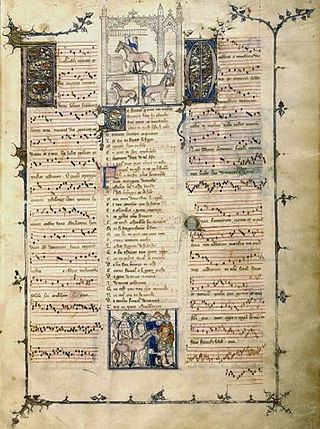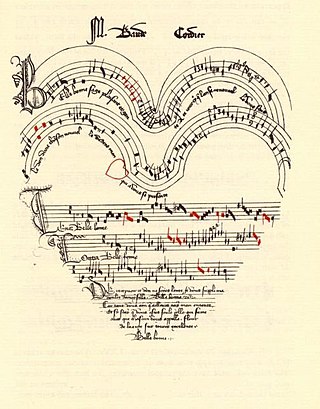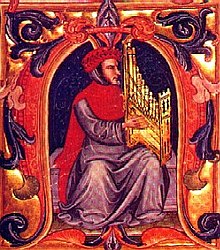
Isorhythm is a musical technique using a repeating rhythmic pattern, called a talea, in at least one voice part throughout a composition. Taleae are typically applied to one or more melodic patterns of pitches or colores, which may be of the same or a different length from the talea.

Ars nova refers to a musical style which flourished in the Kingdom of France and its surroundings during the Late Middle Ages. More particularly, it refers to the period between the preparation of the Roman de Fauvel (1310s) and the death of composer Guillaume de Machaut in 1377. The term is sometimes used more generally to refer to all European polyphonic music of the fourteenth century. For instance, the term "Italian ars nova" is sometimes used to denote the music of Francesco Landini and his compatriots, although Trecento music is the more common term for the contemporary 14th-century music in Italy. The "ars" in "ars nova" can be read as "technique", or "style". The term was first used in two musical treatises, titled Ars novae musicae by Johannes de Muris, and a collection of writings attributed to Philippe de Vitry often simply called "Ars nova" today. Musicologist Johannes Wolf first applied to the term as description of an entire era in 1904.

Ars subtilior is a musical style characterized by rhythmic and notational complexity, centered on Paris, Avignon in southern France, and also in northern Spain at the end of the fourteenth century. The style also is found in the French Cypriot repertory. Often the term is used in contrast with ars nova, which applies to the musical style of the preceding period from about 1310 to about 1370; though some scholars prefer to consider ars subtilior a subcategory of the earlier style. Primary sources for ars subtilior are the Chantilly Codex, the Modena Codex, and the Turin Manuscript.
Niccolò da Perugia was an Italian composer of the Trecento, the musical period also known as the "Italian ars nova". He was a contemporary of Francesco Landini, and apparently was most active in Florence.

Messe de Nostre Dame is a polyphonic mass composed before 1365 by French poet and composer Guillaume de Machaut. Widely regarded as one of the masterpieces of medieval music and of all religious music, it is historically notable as the earliest complete setting of the Ordinary of the Mass attributable to a single composer.
The year 1648 in music involved some significant events.
The decade of the 1510s in music involved some significant events.
Antonello da Caserta, also Anthonello de Casetta, Antonellus Marot, was an Italian composer of the medieval era, active in the late 14th and early 15th centuries.
Leo Schrade was a German-born American musicologist. Among his notable publications are critical editions of works by Guillaume de Machaut and Francesco Landini, the former of which he established the standard numbering scheme for. He also wrote Monteverdi: Creator of Modern Music on Claudio Monteverdi; a controversial but influential work on Monteverdi's place in the history of Western classical music.
The 1370s in music involved some significant events.
The 1340s in music involved some events.
The 1380s in music involved some significant events.
The 1320s in music involved some events.
The 1330s in music involved some events.
The 1350s in music involved some significant events.
The 1300s in music was a decade involving some events.
12th century in music – 13th century in music – 1300s in music
This is a list of notable events in music that took place in the 1470s.




